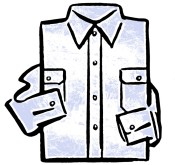 I’ve been spending the last week doing a typical new year task – clearing my house of things. Most people who know me will tell you I’m an organized person and when I say my house is a mess, it’s not as visible to others. I’m one of those people.
I’ve been spending the last week doing a typical new year task – clearing my house of things. Most people who know me will tell you I’m an organized person and when I say my house is a mess, it’s not as visible to others. I’m one of those people.
Most of my cleaning and organizational habits evolved from my childhood, where cleanliness meant control and control meant less anxiety. It was, I thought, in my nature to be a creative slob, but between an OCD parent and years in the Army, my nature was suppressed, mutated and is now clearly unrecognizable from the kid who lost everything. Gone is the child who cleaned by shoving things under the bed, until the pile crept across the floor, like a slow-spreading moss.
Something was lost, even as I learned to keep track of everything. I spend a lot of time keeping things under control. De-cluttering is treatment of the symptoms, but not a cure. The cure is bringing less into one’s home in the first place. The cure is asking yourself what things represent to you and learning that they are not you. The cure is asking yourself, what problem am I trying to solve?
There’s a level of shame and fear associated with my possessions. Many things I bought so that I would never run out, a consistent fear birthed by growing up in poverty. Other  things are bought as a magic pill – looking to an outside source to fix a problem when I don’t trust myself to solve it. There are some things that bring me undiluted pleasure – books, pretty stationery, and good pens. But even then, too much of a good thing waters down one’s appreciation.
things are bought as a magic pill – looking to an outside source to fix a problem when I don’t trust myself to solve it. There are some things that bring me undiluted pleasure – books, pretty stationery, and good pens. But even then, too much of a good thing waters down one’s appreciation.
I’ve read books by a few of the gurus of organization and minimalism – Peter Walsh, Leo Babauta, and Julie Morgenstern. Now, I’m listening to the latest popular organizing book, The Life-Changing Magic of Tidying Up: The Japanese Art of Decluttering and Organizing by Marie Kondo. I downloaded it from my local library, so thankfully, not another acquisition.
 Yesterday it took several hours to go through all my clothes and to put back the ones I liked and wore. I folded the KonMari way, modifying methods to fit the space I have. I have to admit, my wardrobe looks good. The real test will be maintenance. I have a couple of bags of clothes to take to a nonprofit thrift store that benefits people with differing abilities.
Yesterday it took several hours to go through all my clothes and to put back the ones I liked and wore. I folded the KonMari way, modifying methods to fit the space I have. I have to admit, my wardrobe looks good. The real test will be maintenance. I have a couple of bags of clothes to take to a nonprofit thrift store that benefits people with differing abilities.
Seeing what I am getting rid of will remain a stark reminder in my head moving forward. Aspirational shopping. Shopping to feel better about one’s self. Shopping because someone made a comment about what colors look good on you or hearing some offhanded, disdainful comment about casual dress. Decisions based on trying to solve a problem that might not have been a problem at all.
What I have left are the things I’ve always worn, always felt comfortable in, always appreciated – jeans, sweaters, t-shirts, blouses, and of course, fuzzy socks. I am easily seduced by color, with same items in different colors, but my wardrobe reflects my life now – not a life imagined, not a life envied, not a life to impress.
Consumerism poisons the well. Things get marketed to us to fix our flaws, including products that tell us we have too much stuff. There is an irony in the number of books and websites and products that promote minimalism. It’s as twisted as the green movement – convincing us to throw away items for more environmentally friendly wares.
I’m embarrassed to say that I’m still learning to resist the game. When we suffocate and drain this planet of its resources, I won’t be able to stand on principle, but I would be able to stand on the mountain of stuff I’ve purchased and discarded over a lifetime.
Still, recriminations are not useful. What has been useful to me is to think about the psychological impact of having this stuff around me. Thinking about where I got my ideas about possession and ownership, imagining what it would be like to not have things – what would I feel?
So much of what I own is about intent and failure to follow through. I intended to really get into Japanese ink painting. I took a class, bought the supplies, got a couple of books. Now those things sit, sulkily staring back at me everyday, reminding me of yet one more thing I will likely not master, or even practice.
The weight is there and it takes up space not just in my office closet, but in my mind. Every time I see it, I think I should…maybe when…why didn’t I… such a dilettante. It reminds me of a flaw to fix, a problem to solve, and the shame of not completing yet another task. Except it’s not the only thing. Boxes of photos unsorted. Books unread. Materials for projects never completed. So much head space filled with regret, disappointment, disgust – with all the physical reminders to prod me every day.
 I write this, as I struggle with the next phase. My books. My many, many, many books. I love books. I love reading them, touching them, being surrounded by them. I love the library and bookstores and online perusing. The presence of books makes me feel wealthy, smart, and full of potential. Their purposes, to impart information, to comfort, to entertain have been outweighed by my pathology of never-ending hunger.
I write this, as I struggle with the next phase. My books. My many, many, many books. I love books. I love reading them, touching them, being surrounded by them. I love the library and bookstores and online perusing. The presence of books makes me feel wealthy, smart, and full of potential. Their purposes, to impart information, to comfort, to entertain have been outweighed by my pathology of never-ending hunger.
I intend to read all of my books. Someday. And the weight of that intent has filled my space. There is little room for much else. For new ideas. For imagination. For the creativity borne out of time and space not filled with entertainment, impulses easily met, stuff yelling at me to stop ignoring it.
As I sort through them, I see myself bared open – all my wishes and dreams and struggles. Fitness books and cookbooks. Self-help books and books on meditation and depression. Reference books for any subject that caught my interest over the years. So many writing books, many in pristine condition.
Sending them off to the library, secondhand bookstores and Books for Africa will take the edge off. But I know this process is less about the stuff, and more about making room for my life now, making room for that creative slob.